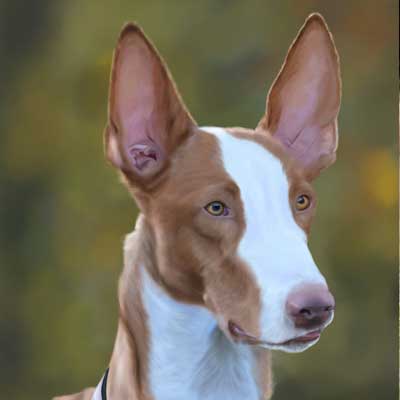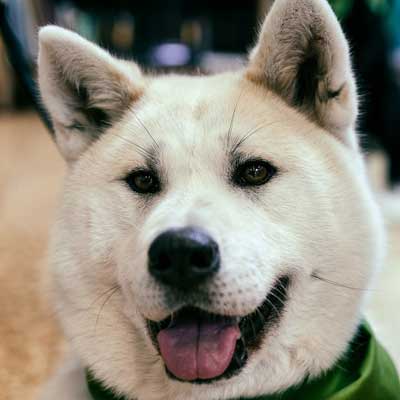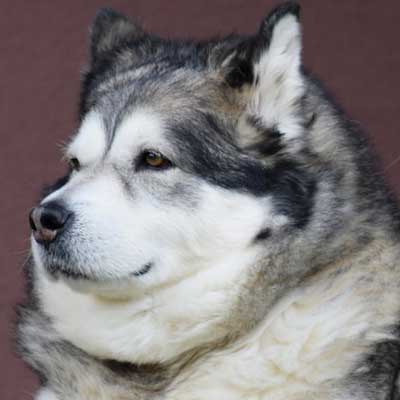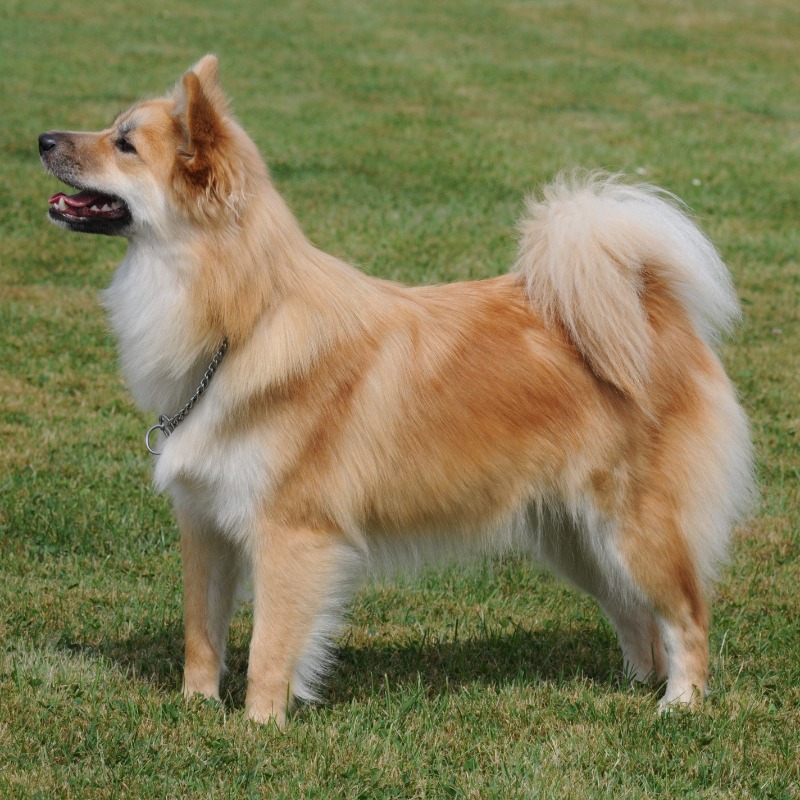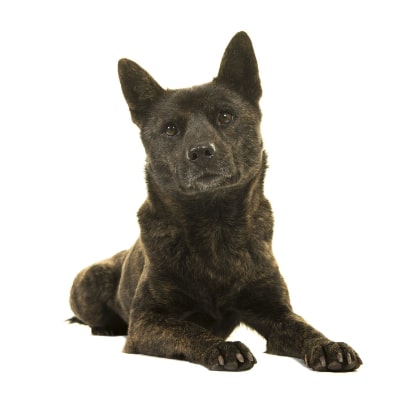Podenco Ibicenco
Mainly used for hunting rabbits without guns, he catches his prey quickly, specially when hunting together with other dogs
-
Head
Seen as a whole, the long, fine head has the appearance of a
cone cut off near its base; completely dry, rather small in relation to body. -
Head - Skull region
Skull: Long and flat (dolichocephalic). Occipital bone protruding.
Forehead fine and flat.
Stop: Barely pronounced. -
Head - face region
Nose: Nose leather flesh colour. Nostrils open. Nasal bridge slightly arched.
Muzzle: Nasal bridge and nose protrude over lower jaw; fine, long and according to colour of coat, flesh colour.
Lips: Thin,close fitting, flesh colour.
Teeth: Perfect fitting bite, scissor bite, white and regular.
Eyes: Slanting, small, light amber colour, reminiscent of caramel colour. The amber colour can be more or less intensive according to coat colour. Without seeming very noble, the expression shows intelligence but also fear and mistrust.
Ears: Always stiff, very mobile. Pointing forward or sideways in a horizontal plane or held backwards. Upright when dog is animated. The center of the ear set on is level with the eyes.
The shape is that of an elongated rhomboid, which has been cut off by a third of its long diagonal.
They are fine without hair on the inside of the ear opening; of medium, not exaggerated size. -
Neck
Very dry, both in its upper and lower part. Its length is a
quarter the length of the body, slightly arched and muscular.
Skin is taut, smooth, without dewlap. Normally, the coat is longer and denser in the region of the set on to the body, especially in the smooth variety. -
Body
Regarded as a whole, the body is symmetric, slightly convex
and of medium, even proportions, compact and slightly longer than heigh, without the differences being laid down exactly.
Withers: Well defined, high, dry and long.
Back: Long, straight and pliable. Muscles strong, yet flat.
Loins: Arched, of medium breadth, strong and firm.
Croup: Strongly sloping with bone structure visible; it shows very strong, hard muscles.
Chest: Deep, narrow and long, but not reaching to the elbows.
Forechest pointed and strongly protruding. Ribs flat.
Underline and belly: Tucked up, but not too much. -
Tail
Set on low; there should be some longer and coarser, slightly
offstanding hairs (like ears of grain) towards the tip; long. When the tail is pulled through between the legs, it should reach the spine.
Slightly thicker at set on, gradually tapering towards the tip.
Hanging naturally in repose; in movement carried in sickle shape more or less tightly curved. Preferably not carried upright or too much curled over back. -
Forequarters
Vertical, symmetric. Seen from front, the position of the front legs is very close together; altogether sturdy, with long limbs which give the impression of a slim, fast, yet strong animal.
Shoulder: Shoulder blades slanting, strong and freely mobile.
Upper arm: Very long, straight, strong and very close in position.
Elbow: Broad, set well apart from the body, parallel to the median plane of the body, but never loose.
Forearm: Broadening towards front pastern.
Pastern: Strong, firm, broad and well upright.
Forefeet: Almost harefoot. Toes long and close together. Profuse hair in space between toes; nails very strong and normally white, occasionally according to coat colour. Pads very hard. -
Hindquarters
Vertical with long, strong, flat muscles.
Hock: Well angulated, broad, set low, vertical, turning neither out nor in.
Hind feet: Almost harefoot. Toes long and close together. Profuse hair in space between toes; nails very strong and normally white, occasionally according to coat colour. Pads very hard. -
Gait / Movement
The preferred movement is a suspended trot.
Gallop is very fast and gives the impression of great agility. -
Skin
Taut, close fitting to body; reddish pigment, but may be a
different colour where coat colour differs. -
Coat - Hair
Smooth rough or long hair.
• The smooth should not be silky, but strong and shiny.
• The rough should be hard and very dense, somewhat shorter on head and ears and somewhat longer on rear of thighs and underside of tail. A beard is highly valued. The longhair is softer and should have at least a length of 5 cm.
The head is very densely coated. -
Coat - colour
Preferred are white and red, or entirely white or red.
Fawn dogs are permitted, provided it is an exceptionally good specimen; in smooth coats, however, this colour is not permitted. -
Height
Dogs: 66 to 72 cm.
Bitches: 60 to 67 cm.
Without undue strictness, dogs which are close to the required measurements can be accepted, provided they are well proportioned and aesthetic. -
Faults
Any departure from the foregoing points should be
considered a fault and the seriousness with which the fault should be regarded should be in exact proportion to its degree and its effect upon the health and welfare of the dog. -
Severe faults
• Head short and broad.
• Stop markedly pronounced.
• Missing of a premolar.
• Drop ears.
• Barrel ribs.
• Elbows turned outwards.
• Cow hocks.
• Feet turned out.
• Crossing of feet and hocks in movement. -
Disqualifying Faults
• Aggressive or overly shy dogs.
• Any dog clearly showing physical or behavioural abnormalities.
• Skull in the shape of a stair (plane of skull too high in relation to nasal bridge).
• Brown pigment or black spots on nose leather.
• Any form of prognathism.
• Eyelids and lips: Reddish brown.
• Evidence of crossing with a « Galgo » or other form of
sighthound:
• Folded ears.
• Dark eyes.
• Croup broad.
• Barely defined forechest.
• Front legs wide apart.
• Thighs rounded and broad with visible veins.
N.B.:
• Male animals should have two apparently normal testicles fully descended into the scrotum.
• Only functionally and clinically healthy dogs, with breed
typical conformation should be used for breeding

